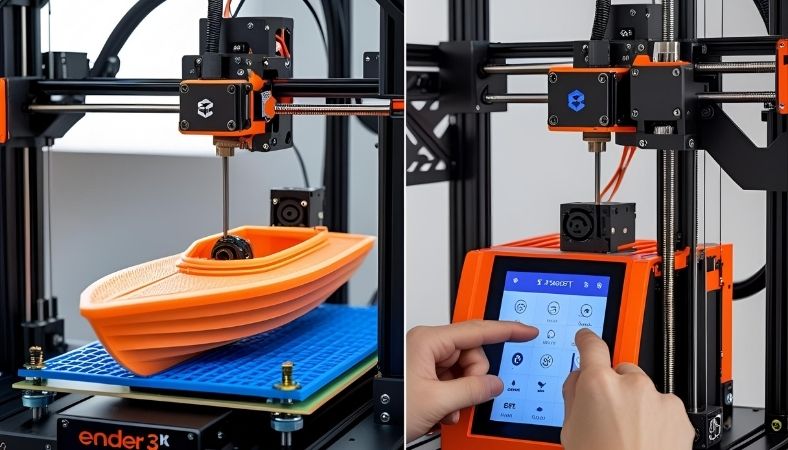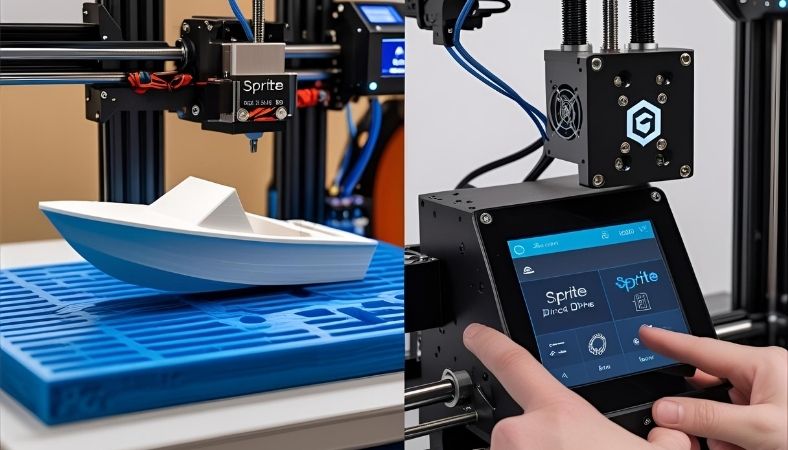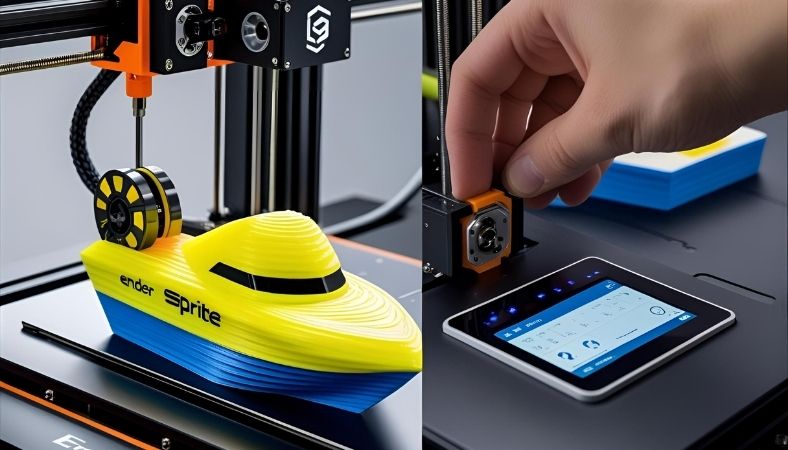You’ve hit ‘print’ on a project, only to realize your old machine crawls like a tired turtle. Enter the Ender 3 V3 KE: a $279 speedster that slashes print times in half. In 2025, it’s still a hobbyist favorite fast, affordable, and forgiving for newbies. But it’s not perfect. Let’s unpack why it shines (and where it trips), with tips to make your prints pop.
What Is the Ender 3 V3 KE?
Imagine a 3D printer that’s like the Honda Civic of the hobby world reliable, moddable, and surprisingly zippy. Launched in late 2023 by Creality, the Ender 3 V3 KE blends high-speed tech with a price that won’t empty your wallet. It’s built for folks who want quick results without a PhD in engineering.
Core Features in Plain English
The KE runs on Creality OS, a Klipper-based system that’s like a traffic cop for your prints—keeping movements smooth at crazy speeds. Its Sprite direct drive extruder pushes filament straight to the nozzle, cutting jams and tackling stretchy stuff like TPU. The PEI build plate grabs prints tightly, so they don’t budge until you’re ready to pop them off.
You get a 220x220x240mm build area—enough for a custom phone stand or a small cosplay prop. With a nozzle hitting 300°C and a bed at 100°C, it handles PLA to ABS like a champ. WiFi and app control let you start prints from your couch, a perk Reddit users rave about for its no-fuss vibe.
What’s New in 2025?
No big hardware leaps this year, but 2025 firmware updates (check GitHub) make it steadier, fixing early WiFi hiccups. The trend? Fast, app-friendly printers under $300 are hot, and the KE holds its own against pricier enclosed models. Bundles with cameras are popping up, letting you spy on prints remotely. Plus, its open-source roots mean you can tweak it to your heart’s content, unlike locked-down competitors.
Setup and Assembly
 Setting up the KE is like building a simple LEGO kit—done in about 30 minutes with no swearing. Picture a Saturday morning, coffee in hand, ready to print your first model. It’s designed to get you there fast, even if you’ve never touched a 3D printer before.
Setting up the KE is like building a simple LEGO kit—done in about 30 minutes with no swearing. Picture a Saturday morning, coffee in hand, ready to print your first model. It’s designed to get you there fast, even if you’ve never touched a 3D printer before.
Easy Setup Steps
Unbox and screw the frame to the base—parts snap together like a dream. Attach the touchscreen, plug in the color-coded wires, and you’re halfway there. Hit power, and the auto self-test calibrates leveling and Z-offset in one go. Load filament (the app makes it a breeze), then run the pre-loaded Benchy test print.
A YouTube vlogger shared how their kid set it up solo in 25 minutes—proof it’s beginner-friendly. X posts from 2025 echo this, with users thrilled at how fast they went from box to first print.
Tips to Nail Your Setup
- Tweak Z-offset manually if prints don’t stick; a tiny nudge fixes most issues.
- Slap on some glue stick for PLA on the PEI plate—keeps things snug.
- Avoid drafts during setup; a steady room temp helps the bed heat evenly. One Reddit user dodged wobbly prints by closing a window—small moves, big wins.
Print Speed and Quality
The KE doesn’t just print—it races. With a max speed of 500mm/s, it’s like upgrading from a bicycle to a motorcycle, churning out a Benchy in 15 minutes. That’s five times faster than basic printers, perfect for impatient creators.
How Fast Is Fast?
At 300mm/s, prints stay crisp with no stringing—Tom’s Hardware gave it 4.5/5 for quality. Push to 500mm/s with 8,000mm/s² acceleration, and you might see slight ripples (called ringing). Enable input shaping in the firmware, and it’s like tightening the suspension on a sports car—smooth and precise.
A 2025 review on stldenise3d.com called its speed “insane” for $279, nailing detailed models like game figurines. Start at lower speeds, then crank it up as you get comfy—think of it as learning to drive stick.
Filament Flexibility
From PLA to TPU, ABS to ASA, the KE handles them all. Its 300°C nozzle loves Hyper PLA for silky flow at high speeds. ABS works great, but an enclosure keeps warping at bay. One hobbyist on X printed flexible TPU phone cases with zero hiccups, a feat older Enders struggled with. In 2025, dry your filament to dodge moisture issues—think of it like keeping your flour fresh for baking.
Comparing the Competition
Picking a printer is like choosing a car—budget and needs steer the choice. The KE sits in a sweet spot: fast, open-source, and wallet-friendly. Let’s see how it stacks up.
Ender 3 V3 KE vs. SE
The KE zooms at 500mm/s with a touchscreen, while the SE chugs at 250mm/s with a basic screen. KE’s hotter nozzle tackles ABS better, but SE saves you $80 at $199. Reddit’s take? Go KE if you print daily; SE’s fine for casual use. It’s like choosing between a smartphone and a flip phone—both work, but one’s flashier.
Vs. Bambu A1 or Neptune 4
The Bambu A1 ($400+) comes enclosed, great for ABS, but it’s pricier and less moddable. The KE’s Klipper edge keeps it competitive, with 2025 reviews praising its value. Neptune 4 matches speed but feels clunkier. If you love tinkering, KE’s your pick; for set-and-forget, Bambu’s enclosure wins. Think of KE as a DIY hot rod—fun to tweak, not as polished.
Upgrades and Mods
 The KE is great stock, but mods make it yours. It’s like customizing a bike—add a bell here, better tires there, and suddenly it’s perfect.
The KE is great stock, but mods make it yours. It’s like customizing a bike—add a bell here, better tires there, and suddenly it’s perfect.
Must-Have Upgrades
Root the firmware for full Klipper access; it’s like unlocking cheat codes for custom settings. A $50 enclosure stabilizes ABS prints by trapping heat. Add a Nebula camera for app monitoring handy for overnight jobs. X users in 2025 swear by fan swaps to hush noise, turning shared spaces peaceful.
Next-Level Tweaks
Try multi-material printing with tool changers for colorful models it’s a bit like advanced LEGO. Energy-saving PSUs cut power use, a nod to 2025’s eco push. A YouTube modder printed Nylon flawlessly with a dry spool and enclosure, showing how far you can push it. These upgrades fix stock limits, like the smaller build area, letting you dream bigger.
Troubleshooting Hiccups
Every printer has quirks, but the KE’s are fixable. It’s like troubleshooting a finicky coffee maker—know the tricks, and you’re golden.
Sticking Prints to the Bed
First-layer fails frustrate 80% of newbies, per Reddit. Adjust Z-offset in the menu—a small tweak works wonders. Clean the PEI plate with alcohol or add hairspray for grip. One user dodged a failed cosplay helmet by re-leveling mid-print—patience pays off.
Smoothing Out Ringing
High speeds can leave ghosting, like faint echoes on prints. Drop to 300mm/s or turn on input shaping—it’s like stabilizing a shaky camera. TechRadar suggests tightening belts for cleaner edges, a fix that turned one user’s blurry models razor-sharp.
Clearing Clogs
Heat creep and clogs hit 20% of users, forums say. Upgrade cooling fans or flush the nozzle with a cleaning kit. Picture a jam ruining your print—swap to an all-metal heatbreak for durability. Regular maintenance keeps the KE humming, especially for ABS.
Pros, Cons, and Value
The Ender 3 V3 KE punches above its weight, but it’s not flawless. Let’s weigh it like you’re picking a new gadget.
Why Beginners Love It
It’s fast, easy, and forgiving—auto features and a vivid UI make printing feel like a game. At $279 (or $223 on sale), it’s a steal, printing five times faster than basic models. High 4.5/5 ratings in 2025 reflect its reliability for daily hobbies, from D&D minis to tool organizers.
Where It Falls Short
No stock enclosure means extra work for ABS or Nylon. WiFi can stutter in Cura, though the app’s solid. Minor noise and ringing at max speeds are trade-offs for the price. It’s like a budget sports car—thrilling but needs occasional tuning.
Your 2025 Printing Adventure
The Ender 3 V3 KE is your ticket to fast, fun 3D printing. Start with simple PLA projects, tweak settings as you grow, and maybe add an enclosure for pro-level prints. Grab it on sale, and you’re set for a hobby that’s as creative as you are—start printing today!
Frequently Asked Questions
What’s the difference between Ender 3 V3 KE and SE?
The Ender 3 V3 KE hits 500mm/s with a touchscreen and 300°C nozzle, ideal for ABS and speedy prints, while the SE maxes at 250mm/s with a basic screen for $199. KE’s Klipper firmware offers smoother control, perfect for frequent use. A Reddit user switched to KE for faster prototypes, saving hours weekly. SE’s great for casual starters, but KE’s the pick for versatility and future tweaks.
How fast can the Ender 3 V3 KE print?
It rockets to 500mm/s with 8,000mm/s² acceleration, printing a Benchy in 15 minutes—five times faster than basic models. Stick to 300mm/s for crisp results; input shaping cuts ringing. A 2025 test printed a detailed model flawlessly at 350mm/s. It’s like swapping a bike for a motorcycle, but tune settings to avoid minor ripples on complex jobs.
Is the Ender 3 V3 KE good for beginners?
Yes, it’s a newbie’s dream with auto-leveling and 30-minute setup. The touchscreen and app make starting prints a snap, no tech degree needed. For $279, it’s a steal with 4.5/5 ratings in 2025. One X user went from zero to printing minis in an hour. Fix adhesion with Z-offset tweaks, and you’re crafting custom gadgets stress-free.
Can the Ender 3 V3 KE print ABS or Nylon?
It handles ABS and ASA at 300°C, and Nylon with a dry spool and $50 enclosure to prevent warping. The direct drive excels with tricky filaments. A YouTube modder nailed Nylon parts using 300°C and a sealed setup. Without an enclosure, ABS might crack in drafts, so prep smart for pro results in 2025.
What firmware does the Ender 3 V3 KE use?
It runs Creality OS, a Klipper-based system for precise, fast prints. Root it via GitHub for custom tweaks like remote control. 2025 updates fixed WiFi glitches, earning 4.5/5 user praise. It’s like a smart assistant for your printer, smoother than Marlin. Beginners stick to stock; pros unlock full Klipper for endless possibilities.
Is the Ender 3 V3 KE worth buying in 2025?
For $279 (or $223 on sale), it’s a top budget pick with 500mm/s speed and open-source flexibility. Beats older Enders but needs an enclosure for ABS vs. Bambu A1’s polish. High 4.5/5 ratings and 2025 trends favor its moddability. One user saved 40 print hours in months—grab it for fast, fun projects.





